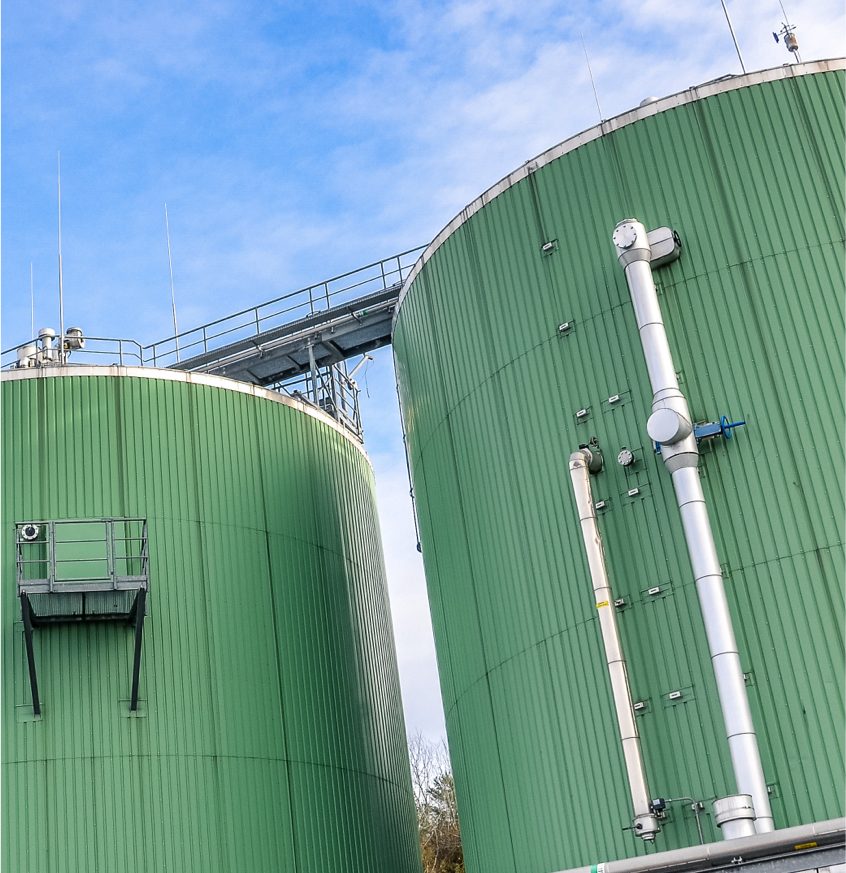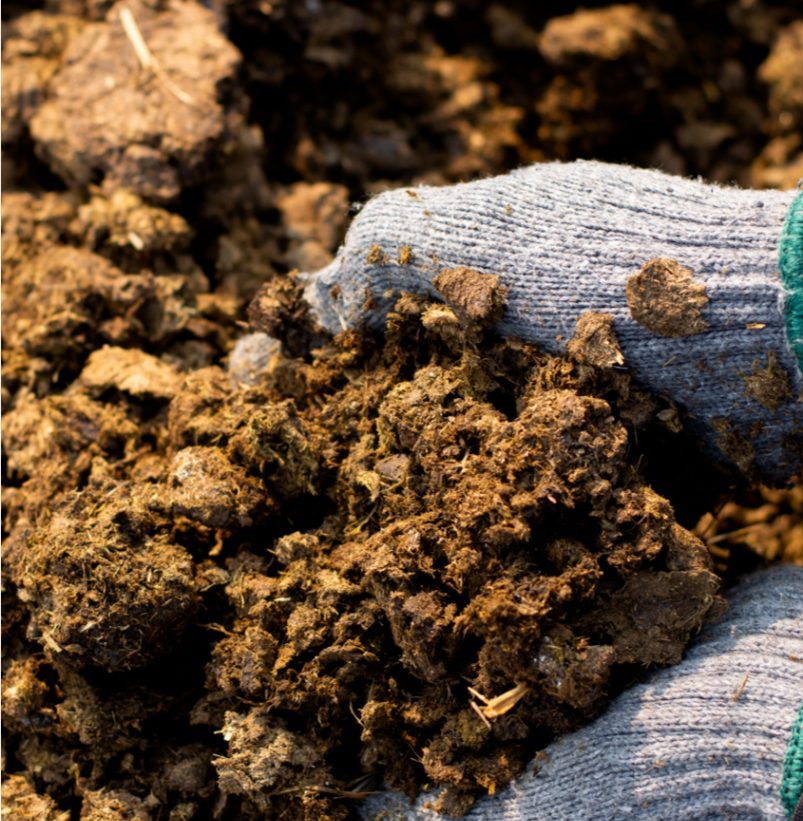To reach net zero we must decarbonise our energy supply. Biogas produced by anaerobic digestion can play an important role in the transition to a low-carbon energy sector and it can offer great co-benefits for both the UK’s climate goals and the agricultural sector.
The UK faces a difficult challenge to reach its net-zero target by 2050. This will require decarbonisation of the energy sector and a shift for many sectors, especially heating and transport, away from fossil fuels and onto electricity. Most of the attention given to low-carbon energy sources has focused on solar and wind power. However, biogas, produced through a process called anaerobic digestion (AD), can also play a role in supporting the net-zero transition. The UK agricultural sector already contributes to the use of AD and biogas production but there is a great opportunity to grow this further, therefore supporting the energy transition whilst providing reliable and affordable energy and boosting rural economies.
AD is the process in which organic matter (e.g., animal/food waste or crop residue) is broken down without oxygen to produce biogas (a mixture of mostly methane and carbon dioxide) and digestate (which can be used as a nutrient-rich fertiliser). Biogas can be used within a combined heat and power (CHP) system or cleaned and injected into the gas grid for use elsewhere. The emissions that are released when biogas is burnt come from the organic matter, which had fixed this carbon from the atmosphere. Therefore, when produced and used properly, biogas offers a carbon-neutral alternative to natural gas and displaces the use of fossil fuels both in generating heat and electricity and producing fertiliser.
There are currently 660 operational AD plants in the UK, with a combined capacity of over 500MWe equivalent, with many more in the development phase. Whilst it is unlikely that the UK will be able to meet its entire gas demand using biogas or meet its climate commitments without significantly reducing gas demand, biogas can still provide a useful tool to reduce emissions.
Biogas can also be used as a low-carbon energy source during the energy transition, using the same infrastructure currently used for natural gas. This can reduce emissions whilst allowing further time for the significant infrastructure investment necessary to electrify the country, such as the large-scale rollout of EV charging ports or installation of electric heat pumps for heating. Additionally, as opposed to other early-stage solutions such as green hydrogen, AD is already widely used around the world and the technology is well understood.
AD has been used for years by the water industry for processing sewage but within the agricultural sector it is still in its relative infancy. Despite this, AD plants can offer a great opportunity for farmers to diversify their business through additional revenue streams, cut costs and reduce their environmental impact. This is particularly important as rising costs and market uncertainty are forcing many farmers to consider how to ensure their business is financially resilient.
AD allows farmers to diversify their business and create additional revenue streams from farm waste and slurry, both through the production of biofuels (for use on-site or to sell) and by producing low-cost, nutrient-rich, fertilizer. When energy and/or digestate are used on farms this can lead to significant cost savings and mitigate the dramatic price rises that have been seen in energy, heating, and farm inputs. This factor makes the potential cost savings from AD increasingly attractive.
Previously, AD plants were able to take advantage of several government schemes, in particular the Renewable Heat Incentive (RHI) and the Feed-In Tariffs (FITs). The removable of these schemes have made it harder to justify the economics for new AD plants. Nonetheless, AD can still be a viable option, especially when combined with a high, on-site, demand for the electricity and/or heat that is produced, such as on-site glasshouses. Controlled-environment growers have been particularly hard hit by rising energy costs and there have been widespread reports of heated glasshouses needing to greatly reduce their production. The ability of AD plants to offer stable and discounted heating and energy may be especially attractive to greenhouse growers.
AD plants can also be used to produce large amounts of CO2, either by cleaning the biogas before it is used or by capturing CO2 from the exhaust of a CHP system. This CO2 can be sold for a range of uses, such as for CO2 fertilizing to increase productivity in greenhouses. Given that this CO2 would have otherwise been released into the atmosphere, it can offer a more climate-friendly alternative to other sources of industrial CO2.
Farmers are faced with increasing demands to reduce their environmental impact both from customers and the incoming Environmental Land Management Schemes (ELMS) in England, and similar schemes in other areas of the UK . Although AD is not directly referenced in the current ELMS guidance there are methods by which AD could help farmers achieve various standards and improve their environmental performance. For example, if processed and used appropriately the digestate can be used to improve and support soil health.
As mentioned above, AD reduces emissions in two ways. Firstly by reducing the emissions from standard slurry storage, and secondly by replacing the use of fossil fuels in electricity, heat, and fertiliser production. A reduction in emissions could be especially useful for beef and dairy herds as retailers increasingly look for farms that can demonstrate their sustainability credentials.
For farms within Nitrate Vulnerable Zones (NVZs) the case for AD becomes more attractive. NVZ regulation encourages responsible slurry management, therefore providing opportunities to implement AD to reduce slurry emissions and pollution. Following on from the recent report on water quality the government has pledged more money for slurry stores which may encourage the uptake of digesters. However, in both cases, limitations on the application of the digestate need to be considered.
Although AD offers a great opportunity to farmers there remain several challenges and barriers to overcome, in particular the financial cost, regulatory requirements, and the technical process of developing and running AD plants.
The installation of AD plants requires upfront capital costs and for larger plants this can become significant, running into the millions of pounds. The payback period for any project is determined by the price received for the heat/electricity produced and the digestate. If a farm can supply all the feed required through waste, then the payback time will be shorter. As with any significant investment a feasibility study should be carried out to ensure that the investment is justifiable.
Digesters must receive sufficient feedstock to maximise their output and maintaining a steady supply of on-farm waste can be difficult for some farms, particularly smaller farms and due to seasonal variations, such as cow slurry availability from overwintering in sheds. Additional feedstock can be sourced from growing specific energy crops or from off-site sources (e.g. waste from other farms or local food waste).
Growing crops specifically for an AD plant is a contentious issue as this can reduce the land available for food production and can harm the environmental credentials of the AD plant. Alternating energy crops and food production has been implemented at scale elsewhere, particularly in Italy, however, this may not be economically viable for all farms. Alternatively, if a digester requires feedstock from off-site then consideration must be given to both the cost and logistics of getting this feedstock and any regulation associated with handling waste or changes to planning permissions.
Again, businesses must ensure that there is a detailed plan for sourcing feedstock for the digester which considers all financial, legal, and environmental aspects.
There are various other challenges and considerations that farmers may face when undertaking an AD project, For example:
- Ensuring that digestate is treated appropriately to remove excess water content to make the remaining digestate cheaper to store and more convenient to use.
- Negotiating a robust and profitable Power Purchase Agreement (PPA) to ensure the business receives the best deal for its power.
- Taking into consideration any planning permissions and health and safety requirements.
Overall anaerobic digestion can offer a great opportunity for farms, and the UK as a whole, to create a low emission, reliable energy source simultaneously helping the net-zero transition, improving energy security, and enriching farm businesses. However, as with any major project, this could require significant work and planning to ensure an AD plant is appropriate and successful. At Climate Spheres UK we can work with your business to evaluate if AD is the right option for your business. We offer services to help farmers understand what options are available to them with regard to business diversification and what projects they could undertake to make their farms more financially and environmentally sustainable. We can provide expert guidance across a range of projects and investments. Our services include feasibility assessments, technical analysis, market research, and assistance in obtaining grants and funding, including support in crafting a business plan.
To learn about Climate Spheres UK, or to understand how the work we are doing can benefit you or your organisation, please get in touch.



















